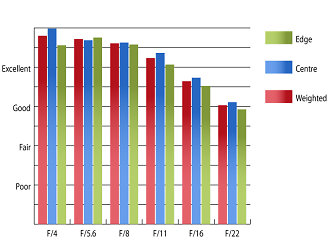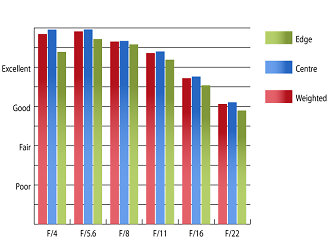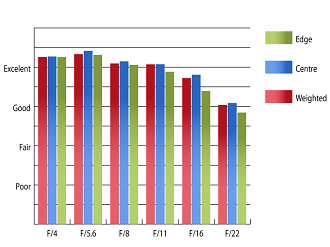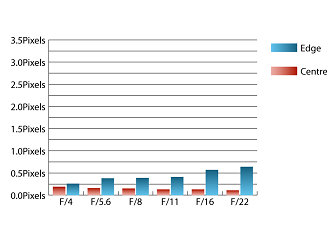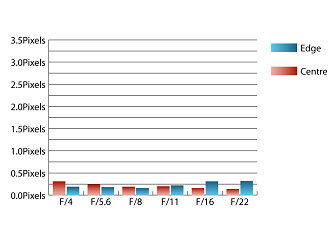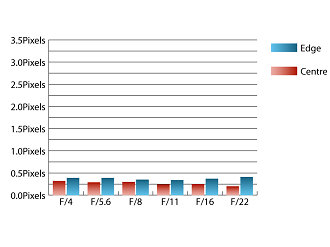Canon EF 16-35mm f/4 L IS USM Lens Review
Canon EF 16-35mm f/4 L IS USM Performance
As far as sharpness is concerned, this is one of the best zoom lenses we have tested so far. Between 16mm and 24mm, sharpness is already outstanding across the frame from maximum aperture, with none of the soft corner issues found with the older 17-40mm optic. Stopping down at this focal length will purely be a creative decision, based on your required depth of field, as the levels of sharpness attained by this lens are only limited by diffraction as the aperture is closed with this lens. Sharpness remains excellent across the frame until the lens is stopped down beyond f/11.
Even when the lens is zoomed to 35mm, sharpness remains excellent across the frame at maximum aperture, and remains so until the aperture is closed down to between f/8 and f/11 for this focal length.
How to read our charts
The blue column represents readings from the centre of the picture frame at the various apertures and the green is from the edges. Averaging them out gives the red weighted column.The scale on the left side is an indication of actual image resolution. The taller the column, the better the lens performance. Simple.
For this review, the lens was tested on a Canon EOS 5D Mark III using Imatest.
Chromatic aberrations are extremely well controlled for a lens of this type, just exceeding half a pixel width at f/22 and 16mm. This low level should cause very virtually no issues, even in large prints and harsh crops from the edges of the frame.
How to read our charts
Chromatic aberration is the lens' inability to focus on the sensor or film all colours of visible light at the same point. Severe chromatic aberration gives a noticeable fringing or a halo effect around sharp edges within the picture. It can be cured in software.Apochromatic lenses have special lens elements (aspheric, extra-low dispersion etc) to minimize the problem, hence they usually cost more.
For this review, the lens was tested on a Canon EOS 5D Mark III using Imatest.
Falloff of illumination towards the corners of the frame is reasonably well controlled for a lens covering such a wide angle of view, with the corers only being two stops darker than the image centre at 16mm and 1.6 stops darker than the centre at 35mm. However, as the lens is stopped down, illumination in the far corners never seems to even up with the rest of the frame entirely even when stopped down to f11, or f16, where you would normally expect uniform illumination from corner to corner.
Distortion is reasonable for a lens of this type. At 16mm 4.26% barrel distortion is present, which is replaced by 0.984% pincushion distortion at 35mm. The distortion pattern is not uniform across the frame at 16mm, with a slight wave being present in straight lines parallel to the edge of the frame. This may make applying corrections in image editing software afterwards tricky, unless the software you use has a preset distortion profile to use.
Even without the supplied petal shaped lens hood, resistance to flare is high and contrast is excellent, even when shooting into the light.
Value For Money
It's quite strange that this lens costs around £1200, when Canon's 16-35mm f/2.8L USM can be picked up for around £50 less at around £1150. Although the f/2.8 lens lacks image stabilisation, it does have a faster, constant f/2.8 maximum aperture. It's just not the way Canon's lens lines are usually priced.
Those after a bargain, who don't need an f/2.8 maximum aperture, don't need image stabilisation, and can live with softness in the far corners may also look to the older 17-40mm f/4L lens, which can be picked up for around £600.
The closest equivalent currently available from third party manufacturers is Tokina's 16-28mm f/2.8 AT-X FX lens, which does cover a shorter zoom range and lacks image stabilisation, but sports a fast constant f/2.8 maximum aperture and costs around £600.
Canon EF 16-35mm f/4 L IS USM Verdict
There can be no doubt that from an optical standpoint, this is one of the finest wide angle lenses Canon has produced to date. Images are razor-sharp across the frame from maximum aperture and CA levels are kept well under control.
The slightly wavy distortion pattern, and vignetting that never seem to go away may put some people off this lens, but at least these issues can be corrected by software afterwards. The price will be the bitterest pill to swallow, especially as the f/2.8 lens from Canon is actually less expensive at the moment. The price will probably settle at a more reasonable level as time passes though.
Even with the odd niggle, they probably won't be enough of an issue to put most prospective buyers off what is currently Canon's sharpest wide angle lens to date.
Canon EF 16-35mm f/4 L IS USM Pros
 Outstanding sharpness across the frame from maximum aperture
Outstanding sharpness across the frame from maximum aperture
 Excellent build quality
Excellent build quality
 Relatively lightweight
Relatively lightweight
 Reasonably low distortion
Reasonably low distortion
 Low CA
Low CA
 Image stabilisation
Image stabilisation
 Fast autofocus
Fast autofocus
 Dust and moisture resistance
Dust and moisture resistance
Canon EF 16-35mm f/4 L IS USM Cons
 Distortion is wavy at 16mm
Distortion is wavy at 16mm
 Far corners remain darker than the image centre, even when stopped down to f/16
Far corners remain darker than the image centre, even when stopped down to f/16
| FEATURES |  |
|
| HANDLING |  |
|
| PERFORMANCE |  |
|
| VALUE FOR MONEY |  |
|
| VERDICT |  |

The Canon EF 16-35mm f/4 L IS USM is one of the finest wide-angle lenses Canon has produced.
Specifications
Add your message
Please login here or if you've not registered, you can register here. Registering is safe, quick and free.
photodo Stats
428 MTF tests
74 in-depth photodo reviews
100+ users join each day
Help the lens community by reviewing or rating a lens today via our lens search
Latest Lens Reviews
- Chinon 28mm f/2.8 Vintage Lens Review
- Canon EF 70-200mm f/4L IS II USM Lens Review
- Samyang AF 85mm f/1.4 EF Review
- Sigma 70mm f/2.8 DG Macro Art Review
- Samyang AF 24mm f/2.8 FE Review
- Meike 50mm f/1.7 Review
- Tamron 70-210mm f/4 Di VC USD Review
- Lensbaby Burnside 35mm f/2.8 Review
- Asahi Super Takumar 50mm f/1.4 Review
- Asahi Super-Multi-Coated Takumar 135mm f/3.5 Review
